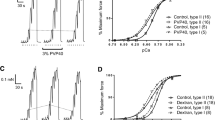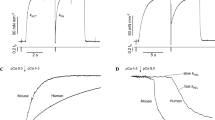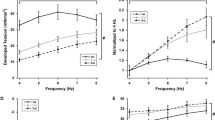Summary
(1) The location of dystrophin in normal muscle, its molecular structure and associations, characterize it as a component of the submembrane cytoskeleton. When dystrophin is missing the cystoskeleton will therefore be defective, and it has been supposed that this renders the muscle membrane more vulnerable to mechanical damage. With the discovery of animal strains lacking in dystrophin, this hypothesis has been put to experimental tests. Contradictory results have been obtained by workers using different exercise regimens and different indices of fibre damage.
(2) Direct measurements of the tensile strength of the membrane have been made on patches of cultured myotubes or isolated muscle fibres, and on sarcolemmal vesicles by pipette aspiration. Neither method has revealed a difference in the tensile strength between normal and dystrophic membrane. The most plausible explanation is that the tensile strength of the membrane is a property more of the lipid bilayer than of the cytoskeleton.
(3) In another experimental approach tensile membrane stress has been produced by exposing isolated muscle fibres and myotubes in culture to hypotonic solutions. In such experiments fibres and myotubes lacking dystrophin have been found to lyse more readily than do normal ones. This difference does not conflict with the similarity in tensile strength of normal and dystrophic fibre membranes noted above. Rather, the predisposition to osmotic lysis of dystrophic fibres and myotubes may signify a lower ratio of membrane surface to cell volume, perhaps as a result of loss of some of the spare membrane normally possessed by skeletal muscle fibres and myotubes.
(4) In red blood cells the membrane cytoskeleton functions to maintain membrane deformability and stability. Deficiency in spectrin, the main cytoskeletal component, predisposes red cells to cytoskeletal rupture and membrane loss when they experience shear stress. Skeletal muscle fibres, especially long fibres contracting eccentrically, are susceptible to shear stress as a result of uneven contraction along their length. In that event, fibres lacking dystrophin may similarly shed membrane more readily.
Similar content being viewed by others
References
Bodensteiner JB, Engel AG (1978) Intracellular calcium accumulation in Duchenne dystrophy and other myopathies: A study of 567,000 muscle fibers in 114 biopsies.Neurology 28:439–446.
Boyle PJ, Conway EJ (1941) Potassium accumulation in muscle and associated changes.J Physiol 100:1–63.
Bulfield G, Siller WG, Wight PAL, Moore KJ (1984) X chromosome-linked muscular dystrophy (mdx) in the mouse.Proc Natl Acad Sci USA 81:1189–1192.
Burton FL, Dörstelmann U, Hutter OF (1988) Single channel activity in sarcolemmal vesicles from human and other mammalian muscles.Muscle Nerve 11:1029–1038.
Byers TJ, Kunkel LM, Watkins SC (1991) The subcellular distribution of dystrophin in mouse skeletal, cardiac and smooth muscle.J Cell Biol 115:411–422.
Campbell KP, Kahl SD (1989) Association of dystrophin and an integral membrane glycoprotein.Nature 338:259–262.
Carpenter S, Karpati G (1979) Duchenne muscular dystrophy plasma membrane loss initiates muscle cell necrosis unless it is repaired.Brain 102:147–161.
Chasis JA, Agre P, Mohandas N (1988) Decreased membrane mechanical stability and in vivo loss of surface area reflect spectrin deficiencies in hereditary spherocytosis.J Clin Invest 82:617–623.
Cooper BJ (1989) Animal models of Duchenne and Becker muscular dystrophy.Br Med Bull 45:703–718.
Cullen MJ, Walsh J, Nicholson LVB, Harris JGB (1990) Ultrastructural localization of dystrophin in human muscle using gold immunolabelling.Proc R Soc Lond B 240:197–210.
Davson H (1951)Textbook of General Physiology. London: Churchill
Delaporte C, Dautraux B, Rouche A, Fardeau M (1990) Changes in surface morphology and basal laminae of cultured cells from Duchenne muscle dystrophy patients.J Neurol Sci 95:77–88.
Dulhunty AF, Franzini-Armstrong C (1974) Caveolae as specialized structural components of the surface membrane of skeletal muscle.Fedn Proc 33:901.
Dulhunty AF, Franzini-Armstrong C (1975) The relative contribution of the folds and caveolae to the surface membrane of frog skeletal muscle fibres of different sarcomere lengths.J Physiol 250:513–539.
Ervasti JM, Campbell KP (1991) Membrane organization of the dystrophin-glycoprotein complex.Cell 66:1–20.
Evans EA (1973) New membrane concept applied to the analysis of fluid shear- and micropipette-deformed red blood cells.Biophys J 13:941–954.
Evans EA, Waugh R, Melnick L (1976) Elastic area compressibility modulus of red cell membrane.Biophys J 16:585–595.
Evans CA, Gordon JF, Hutter OF, Kusel JR (1990) Lateral mobility of membrane glycoprotein in chick myotubes and in skeletal muscle fibres isolated from normal and mdx mice.J Physiol 429:54P.
Fiehn W, Peter JB, Mead JF, Gan-Elepano M (1971) Lipid and fatty acids of sarcolemma, sarcoplasmic reticulum and mitochondria from rat skeletal muscle.J Biol Chem 246:5617–5620.
Franco A, Lansman JB (1990) Calcium entry through stretch-inactivated ion channels in mdx myotubes.Nature 344:670–673.
Guharay F, Sachs F (1984) Stretch-activated single channel ion currents in tissue-cultured embryonic chick skeletal muscle.J Physiol 352:685–701.
Hammonds R Glen Jr (1987) Protein sequence of DMD gene is related to actin-binding domain of α-actin.Cell 51:1.
Hoffman EP, Brown RH, Kunkel LM Dystrophin: the protein product of the Duchenne muscular dystrophy locus.Cell 51:919–928.
Hutter OF, Burton FL, Bovell DL (1991) Mechanical properties of normal andmdx mouse sarcolemma: bearing of function of dystrophin.J Muscle Res Cell Motil 12:585–589.
Jackson MJ, Jones DA, Edwards RHT (1985) Measurements of calcium and other elements in muscle biopsy samples from patients with Duchenne muscular dystrophy.Clin Chim Acta 147:215–221.
Jackson MJ, Round JM, Newham DJ, Edwards RHT (1987) An examination of some factors influencing creatine kinase in the blood of patients with muscular dystrophy.Muscle Nerve 10:15–21.
Koenig M, Kunkel LM (1990) Detailed analysis of the repeat domain of dystrophin reveals four potential hinge segments that may confer flexibility.J Biol Chem 265:4560–4566.
Koenig M, Monaco AP, Kunkel LM (1988) The complete sequence of dystrophin predicts a rod-shaped cytoskeletal protein.Cell 53: 219–228.
Levine BA, Moir ATG, Patchell VB, Perry SV (1992) Binding sites involved in the interaction of actin with the N-terminal region of dystrophin.FEBS Lett 298: 44–48.
Maunder-Sewry CA, Gorodetsky R, Yarom R, Dubowitz V (1980) Elemental analysis of skeletal muscle in Duchenne muscular dystrophy using X-ray fluorescence spectrometry.Muscle Nerve 3:502–508.
McArdle A, Edwards RHT, Jackson MJ (1991) Effects of contractile activity on muscle damage in the dystrophin-deficientmdx mouse.Clin Sci 80:367–371.
McCully K, Giger R, Argov Z, Valentine B, Cooper B, Chance B, Bank W (1991) Canine X-linked muscular dystrophy studied with in vivo phosphorus magnetic resonance spectroscopy.Muscle Nerve 14:1091–1098.
Menke A, Jockusch H (1991) Decreased osmotic stability of dystrophin-less muscle cells from themdx mouse.Nature 349:69–71.
Mongini T, Ghigo D, Doriguzzi C, Bussolino F, Pescarmona G, Pollo B, Schiffer D, Bosia A (1988) Free cytophasmic Ca++ at rest and after cholinergic stimulus is increased in cultured muscle cells from Duchenne muscular dystrophy patients.Neurology 38:476–480.
Needham D, Nunn RS (1990). Elastic deformation and failure of lipid bilayer membranes containing cholesterol.Biophys J 58:997–1009.
Newham DJ, McPhail G, Mills KR, Edwards RHT (1983) Ultrastructural changes after concentric and eccentric contractions of human muscle.J Neurol Sci 61:109–122.
Ohlendieck K, Campbell KP (1991) Dystrophin-associated proteins are greatly reduced in skeletal muscle from mdx mice.J Cell Biol 115:1685–1694.
Ponder E (1955) Red cell structure and its breakdown.Protoplasmatologia 10:1–123.
Rowland LP (1976) Pathogenesis of muscular dystrophies.Arch Neurol 33:315–321.
Sacco P, Jones DA, Dick JRT, Vrbova G (1992) Contractile properties and susceptibilty to exercise-induced damage of normal and mdx mouse tibialis anterior muscle.Clin Sci 82 227–236.
Sakmann B and Neher E (1983) Geometric parameters. In Sakmann B, Neher E, eds.Single Channel Recording New York: Plenum Press, 37–51.
Sammit CE, Bonilla E (1990) Immunocytochemical study of dystrophin at the myotendinous junction.Muscle Nerve 13:493–500.
Sewry CA, Dubowitz V, Abraha A, Luzio JP, Campbell AK (1987) Immunocytochemical localisation of complement components C8 and C9 in human diseased muscle: The role of complement in muscle fibre damage.J Neurol Sci 81:141–153.
Sheetz MP (1983) Membrane skeletal dynamics: role in modulation of red cell deformability, mobility of transmembrane proteins, and shape.Semin Hematol. 20:175–188.
Shields M, La Cell P, Waugh RE, Scholz M, Peters R, Passow H (1987). Effects of intracellular Ca2+ and proteolytic digestion of the membrane skeleton on the mechanical properties of the red blood cell membrane.Biochim Biophys Acta 905:181–184.
Sicinski P, Geng Y, Ryder-Cook AS, Barnard EA, Darlison MG, Barnard PJ (1989) The molecular basis of muscular dystrophy in the mdx mouse: a point mutation.Science 244:1578–1580.
Tidball JG, Law DG (1991). Dystrophin is required for normal thin filament-membrane association at myotendinous junctions.Am J Pathol 138:17–21.
Turner PR, Westwood T, Regen CM, Steinhardy RA (1988) Increased protein degradation results from elevated free calcium levels found in muscle frommdx mice.Nature 335: 735–738.
Waugh RE, Agre P (1988) Reductions of erythrocyte membrane viscoelastic coefficients reflect spectrin deficiencies in hereditary spherocytosis.J Clin Invest 18:133–141.
Webster C, Silberstein L, Hays AP, Blau HM (1988) Fast muscle fibres are preferentially affected in Duchenne muscular dystrophy.Cell 52:503–513.
Weller B, Karpati G, Carpenter S (1990) Dystrophin-deficient mdx muscle fibers are preferentially vulnerable to necrosis induced by experimental lengthening contractions.J Neurol Sci 100: 9–15.
Zubrzycka-Garn EE, Bulmann DE, Karpati G, Burghes AHM, Belfall B, Klamut HJ, Talbot J, Hodges RS, Ray PN, Worton RG (1988) The Duchenne muscular dystrophy gene product is localized in sarcolemma of human skeletal muscle.Nature 333:466–469.
Zubrzycka-Garn EE, Hutter OF, Karpati G, Klamut HJ, Bulman DE, Hodges RS, Worton RG, Ray PN (1991) Dystrophin is tightly associated with the sarcolemma of mammalian skeletal muscle fibres.Exp Cell Res 192:278–288.
Author information
Authors and Affiliations
Rights and permissions
About this article
Cite this article
Hutter, O.F. The membrane hypothesis of duchenne muscular dystrophy: Quest for functional evidence. J Inherit Metab Dis 15, 565–577 (1992). https://doi.org/10.1007/BF01799615
Issue Date:
DOI: https://doi.org/10.1007/BF01799615




